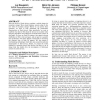27 search results - page 1 / 6 » uFLIP: Understanding the Energy Consumption of Flash Devices |
DEBU
2010
13 years 2 months ago
2010
Understanding the energy consumption of flash devices is important for two reasons. First, energy is emerging as a key metric for data management systems. It is thus important to ...
CIDR
2009
13 years 6 months ago
2009
Does the advent of flash devices constitute a radical change for secondary storage? How should database systems adapt to this new form of secondary storage? Before we can answer t...
SIGMOD
2010
ACM
13 years 10 months ago
2010
ACM
It is amazingly easy to get meaningless results when measuring flash devices, partly because of the peculiarity of flash memory, but primarily because their behavior is determin...
DAC
2004
ACM
14 years 6 months ago
2004
ACM
The need for low-power, small factor secondary storage device has led to the widespread use of flash memory in embedded systems. The energy consumption of processor and flash base...
DATE
2009
IEEE
14 years 1 days ago
2009
IEEE
Abstract—Recent breakthroughs in circuit and process technology have enabled new usage models for non-volatile memory technologies such as Flash and phase change RAM (PCRAM) in t...

